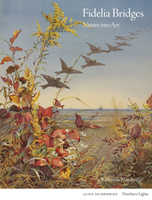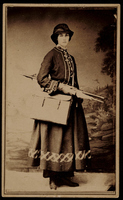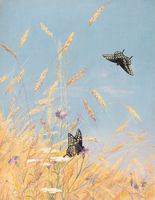Fidelia Bridges: Nature into Art by Katherine Manthorne
Reviewed by Kim OrcuttKim Orcutt
Independent scholar
Email the author: kimorcutt301[at]gmail.com
Citation: Kim Orcutt, book review of Fidelia Bridges: Nature into Art by Katherine Manthorne, Nineteenth-Century Art Worldwide 23, no. 2 (Autumn 2024), https://doi.org/10.29411/ncaw.2024.23.2.11.
This work is licensed under a Creative Commons Attribution-NonCommercial 4.0 International License  unless otherwise noted.
unless otherwise noted.
Your browser will either open the file, download it to a folder, or display a dialog with options.

Katherine Manthorne,
Fidelia Bridges: Nature into Art.
London: Lund Humphries, 2023.
128 pp.; 60 color illus.; appendix; notes; index.
£35.00 (hardcover)
ISBN: 9781848225480
The monograph—the narrative life-and-works format that introduced scholars to so many of the key figures of the history of US art in the early years of the field—has become a relative rarity, largely because so much of that work has already been done, laying the foundations that form the basis of much current scholarship. It is easy to take these works for granted and to forget how difficult and thankless they can be. With a lifetime’s worth of material, artworks, and events, the author must decide what to include and exclude; how to divide a lifetime into coherent periods; how to flesh out the artist’s life in the context of their time; and how to balance the personal with the professional. And of course, the author must offer themes and insights that lend coherence to the story without being reductive or restricting. Published at the centenary of the artist’s death, Katherine Manthorne’s Fidelia Bridges: Nature into Art accomplishes all of this in the service of an important but understudied artist, illuminating not only the subject’s life, but also the artistic milieu of her long career as “the best-selling female artist in post-Civil War America” (9).
While the book is only available in hardcover and not as a paperback or e-book, it is refreshingly affordable and well-suited to the subject. Compact and nicely laid out, it is the proper size and format for the material presented. Bridges’s focus on the watercolor medium has not helped her reputation with posterity, as these light-sensitive works are rarely exhibited. However, the volume includes beautiful illustrations that, given the intimate scale of many of Bridges’s works, show them at nearly actual size, providing the reader with a better understanding of her oeuvre than is usually possible.
Manthorne’s methodology arises naturally from her subject and her materials: rather than attempting to apply a potentially flattening heuristic to the artist’s life, Manthorne’s themes develop organically from the study of Bridges’s life, work, and the various forms of documentation that record her long career. The sometimes-quirky materials include Bridges’s correspondence, reminiscences, a scenario for a play, and a list of books in her library. Placing these alongside insightful formal analyses of Bridges’s works, the author undertakes a chrono-thematic narrative that tracks the artist’s training, professional success, mature career, and later years, roughly by decade. In the preface and introduction, Manthorne explains her project to show how the artist’s life (1834–1923) informed her work over an eventful career of more than fifty years and to bring to light her achievement in “single-handedly transforming flower painting from a domestic outlet for female amateurs to a marketable commodity of professional artists” as she “conceived her pictures as weapons in the struggle for nature conservation” (10). As one of only two female members of New York’s National Academy of Design (the other was Eliza Greatorex, the subject of another Manthorne study[1]), the author posits that Bridges led a double life: not merely the stereotyped reclusive spinster, Bridges also maintained an active presence in New York City’s art world and had a large circle of prominent friends. In the introduction, Manthorne presents several themes that recur throughout the book by exploring Bridges’s many roles: watercolorist, painter of field flowers, artist-ornithologist, fine artist and popular illustrator, and nature conservator. The author notes the importance of Asian influences on Bridges’s work—particularly the Japanese prints that grew in popularity in the late nineteenth century—and attends to issues of self-fashioning and the artist’s strategies for navigating the art world as a female practitioner. Manthorne argues for Bridges’s worthiness as a subject of in-depth study and encourages a closer, more nuanced view that celebrates the aesthetic qualities of her work without apologizing for her success engaging a broad popular audience, despite its impact on her long-term reputation.

Chapter 1, “Apprenticeship, Ambition, and Adventure, 1850s–60s,” traces Bridges’s early life in Salem, Massachusetts. The tragic loss of her parents at a young age left the three Bridges sisters to make their own way (with a younger brother striking out on his own and eventually settling in England). While recovering from an illness, Fidelia turned to the study and rendering of nature, leading to her first works in Salem. The author sketches a portrait of the town and its immersion in overseas trade, introducing the types of objects and aesthetics that would shape Bridges’s mature work. A move to Brooklyn in 1854 introduced the artist to important lifelong friends, including the William Augustus Brown family, who began as her employers and continued as friends and patrons, and sculptor Anne Whitney, whose active involvement with the suffrage and conservation movements suggest that Bridges may have shared her views to some extent. In 1860, Bridges began her studies at the Pennsylvania Academy of the Fine Arts in Philadelphia, a city with a history of supporting women artists. Bridges flourished under the tutelage of the Ruskinian disciple William Trost Richards, who also became a lifelong friend and supporter. Manthorne looks at the artist’s student work and early plein-air paintings, noting the difficulty of the watercolor medium and the close observation and meticulous techniques that would mark her mature work. The chapter ends felicitously by examining a bold act of self-fashioning on Bridges’s part: an 1865 carte-de-visite of the artist on the cusp of her professional career, dressed and equipped as an outdoor painter against a backdrop of wooded hills (fig. 1).
Bridges’s early career is the subject of chapter 2, “Becoming a Professional Artist: From Brooklyn to Europe.” Upon finishing her art studies in Philadelphia, the artist returned to Brooklyn. Despite entering the art world during the low ebb of the Civil War period, Bridges made inroads, improving her fragile health with summer drawing excursions and exhibiting at the National Academy of Design, the Brooklyn Art Association, and later, the Brooklyn and Long Island Sanitary Fair, the Great Central Fair in Philadelphia, and the Artists’ Fund Society. The author provides useful contextual information on contemporary practices that are often cited but rarely explained, such as Varnishing Day and opening receptions. Manthorne expands on Bridges’s involvement with the Brown family and the influence of their progressive Quaker beliefs, among other things, concerning stewardship of nature and equality for women. An eighteen-month trip to Europe in 1867 with Anne Whitney is illuminated through personal notes from letters in which the stalwart Bridges relates the difficulties of a woman traveling alone for some parts of her journey (when she was often referred to as Mrs. Bridges because a husband was assumed), and her final six months in Rome among friends and fellow female artists. Manthorne notes that unlike many of Bridges’s fellow travelers who spent their time in cities and museums, the artist continued to be drawn to nature, studying flora and fauna.
“Success in the 1870s” is the focus of chapter 3, which opens with a drawing of the artist and her friends on a plein-air sketching trip that typifies her mature practice. Bridges developed a style that combines naturalist detail with Asian design. She began to spend summers in Connecticut, where she would eventually make her home. Her growing mastery of watercolor came at a period of high interest, with such artists as Winslow Homer and John La Farge embracing the medium. Manthorne mentions Bridges’s membership in the American Water Color Society, as well as her election as an associate member of the National Academy of Design. Her successes mounted with her inclusion in the Memorial Hall display of US art at the 1876 Centennial Exhibition in Philadelphia. The artist was exposed to Asian aesthetic influences during her early years in Salem, readying her for the advent of Japonisme; her embrace of the style contributed to her growing popularity and placed her at the vanguard of the period alongside prominent artists and friends such as La Farge.

During this period, Bridges was approached by publisher Louis Prang to produce “Twelve Months,” a series of works embodying the spirit of each month, produced in the popular form of chromolithographs (see, e.g., fig. 2). Manthorne elucidates the laborious collaborative process and attendant challenges, as seen through the artist’s letters, which offer a sense of the enterprise’s practical difficulties and obstacles. The project was the beginning of a long-term relationship with Prang, both through the commission of more chromos and with him and his wife becoming avid collectors of Bridges’s original works. In a period marked by discussions of cultivating popular taste, Bridges played a key role in widely disseminating images of natural beauty. Once again, Manthorne concludes with a reflection on self-fashioning, discussing the artist’s choices of simple and functional dress evidenced in the many portraits of her (which admittedly leaves the reader wishing that they were illustrated).
Chapter 4, “Travel, Birds, and Holiday Cards, 1880s–90s,” traces Bridges’s mounting recognition as a watercolorist and her growing success. A brief solo exhibition at Reichard’s Gallery in New York City financed a trip to England, where Bridges explored London, the country, and the coast, while also exhibiting at the Royal Academy. Her efforts for Prang continued as she created works reproduced as holiday cards (as did other notable artists such as Thomas Moran and Winslow Homer) for the next twenty years. Bridges settled in Canaan, Connecticut, and the chapter continues with a discussion of the artist’s engagement with nature through the state’s particular geography, her interest in coasts and rivers, her ornithological studies, and her summer stays in Maine, Rhode Island, Cape Cod, and the White Mountains. Manthorne insightfully notes that though Bridges was often identified as a flower painter, she might more accurately be called a “weed woman,” a historical term that applies to her focus on weeds and common plants as well as her quest to find beauty in the humbler aspects of her surroundings. Bridges also made a close study of birds, and the author discusses the challenges of accurately depicting them, especially the time and patience required. The artist provided nine images of birds to illustrate an article by the naturalist John Burroughs for Scribner’s Monthly. Bridges is said to have been outraged by the massacre of birds to provide feathers for the decoration of hats. Her collaboration with Susie Barstow Skelding on a series of high-end colorplate books depicting birds, as well as volumes of illustrations and poetry, encouraged their protection. The chapter ends on a personal note, as Bridges transitioned into her later years in Canaan, enjoying her close (if sadly shrinking) circle of friends, participating in the 1893 World’s Columbian Exhibition, and continuing to exercise her independent nature by taking up bicycle riding.
The book concludes with chapter 5, “Gardens and Friendship Circles: Canaan, 1890–1923.” Settled in her Connecticut home and garden, Bridges’s involvement with Prang ended in 1899, when he closed his greeting card business; the moment was further marked by the sale of Prang’s voluminous personal collection of Bridges’s work. Manthorne takes a 1900 interview of Bridges as a window into the artist’s later life in which she is immersed in her home and garden and surrounded by birds and her pet cats—a relative novelty at the time—in a merging of art and nature. Bridges maintained close contact with her lifelong friends and continued to exhibit occasionally, placing works with William Macbeth in his New York gallery. She also partook of the new experience of “motoring” and made a final trip abroad, visiting England and Holland. The author discusses Bridges’s late style, a sometimes-neglected topic in the study of prominent artists, and raises the intriguing question of whether her looser and more atmospheric treatment can be attributed to physical factors or an attempt to continue her stylistic development, because, as Manthorne points out, she continued working, active and intellectually sharp, until her death at nearly eighty-nine.
The volume includes an appendix cataloguing Bridges’s library that will no doubt become a valuable resource for future scholars. This lapidary account makes the reader wish for a complete listing of the artist’s oeuvre. But here again, the small size and watercolor medium of most of her work militated against her reputation with posterity, as many of them appear to have gone to private collections, making them notoriously difficult to track a century later. It is hoped that this study will inspire future accounting.
Manthorne conveys a sense of the dedication and authenticity of Bridges’s engagement with nature that distinguished her from the legion of flower painters of the period, both male and female. The author has made judicious choices with her material, zooming in and out from the artist’s personal concerns to the mechanisms of the art world, to the larger events that shaped her era, providing clear sections that manage the balance between chronological and thematic material. Fidelia Bridges: Nature into Art provides an attractive, engaging, and scholarly foundational account of a neglected artist that makes the reader want to know more—a clear mark of its success.
Notes
[1] Katherine Manthorne, Restless Enterprise: The Art and Life of Eliza Pratt Greatorex (Berkeley: University of California Press, 2020).